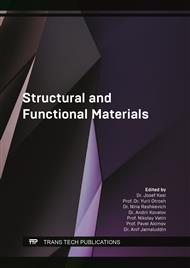[1]
E.V. Korolev, Nanotekhnologiya v stroitel'nom materialovedenii. Analiz sostoyaniya i dostizhenij. Puti razvitiya, Stroitel'nye materialy. Vol. 11, pp.47-79, (2014).
Google Scholar
[2]
V.R. Falikman, Nanocoatings in modern construction, Nanotechnologies in Construction, Vol.13(1), Pp. 5-11, 2021. DOI 10.15828/2075-8545-2021-13-1-5-11.
DOI: 10.15828/2075-8545-2020-13-1-5-11
Google Scholar
[3]
G.I. YAkovlev, G.N. Pervushin, A. Korzhenko, A.F. Bur'yanov, YA. Kerene, I.S. Maeva, D.R. Hazeev, I.A. Pudov and S.A. Sen'kov, Primenenie dispersij mnogoslojnyh uglerodnyh nanotrubok pri proizvodstve silikatnogo gazobetona avtoklavnogo tverdeniya, Stroitel'nye materialy, Vol.2, Pp. 25-29, (2013).
Google Scholar
[4]
T.A. SHabanova, N.G. Prihod'ko, M. Auelhankyzy and Z.A. Mansurov, Fullerity i struktury rosta" nanoob,ektov, Inzhenerno-fizicheskij zhurnal, vol.89(4), pp.1034-1040, (2016).
Google Scholar
[5]
V.A. Eremeyev, On effective properties of materials at the nano- and microscales considering surface effects, Acta Mechanica, vol.227 (1), pp.29-42, 2016.
DOI: 10.1007/s00707-015-1427-y
Google Scholar
[6]
X. Jiang, T.L. Kovald, T. Staedler and R.H.F. Trettin, Carbon Nanotubes As A new Reinforcement Material for Modern Cement-Based Materials, Proceedings of the 2 nd International Symposium on Nanotechnology in Construction, RILEM Publications s.a.r. I, p.26, (2005).
Google Scholar
[7]
YU.M. Bazhenov, V.R. Falikman and B.I. Bulgakov, Nanomaterialy i nanotekhnologii v sovremennoj tekhnologii betonov, Vestnik MGSU, vol.12, pp.125-133, (2012).
DOI: 10.22227/1997-0935.2012.12.125-133
Google Scholar
[8]
S. Samchenko, I. Kozlova and O. Zemskova, Model and mechanism of carbon nanotube stabilization with plasticizer, MATEC Web of Conferences. Vol. 193, No. 03050, 2018,.
DOI: 10.1051/matecconf/201819303050
Google Scholar
[9]
I. Campillo, J.S. Dolado and A. Porro, High – Performance Nanostructured Materials for Construction, Proceedings of the lst international Symposium on Nanotechnology in Construction, Paisley, p.110 – 121, (2003).
DOI: 10.1039/9781847551528-00215
Google Scholar
[10]
G.Y. Li, P.M. Wand and X. Zhao, Mechanical behavior and microstructure of cement composites incorporating Surfacetreated multi-walled carbon nanotubes, Carbon, vol. 43, p.1239 – 1245, (2005).
DOI: 10.1016/j.carbon.2004.12.017
Google Scholar
[11]
S.V. Samchenko, I.V. Kozlova and O.V. Zemskova, Model and mechanism of stabilization of carbon nanotubes with placticizer on the basis of sulfonated naphthalene formaldehyde resins, Materials Science Forum, vol. 931, pp.481-488, 2018.
DOI: 10.4028/www.scientific.net/MSF.931.481
Google Scholar
[12]
G.I. Yakovlev, I.S. Polianskich, I.A. Pudov, S.V. Sychugov, E.A. Karpova, G. Skripkiunas, O.Lahayne, J. Eberhardsteiner, L.A. Urkhanova and S.A. Sen'Kov Modification of cement matrix using carbon nanotube dispersions and nanosilica, Procedia Engineering, pp.1261-1269, (2017).
DOI: 10.1016/j.proeng.2017.02.148
Google Scholar
[13]
E.V. Korolev and A.S. Inozemcev, Effektivnost' fizicheskih vozdejstvij dlya dispergirovaniya nanorazmernyh modifikatorov, Stroitel'nye materialy, vol. 1, pp.1-4,(2012).
Google Scholar
[14]
S.V. Samchenko, I.V. Kozlova, O.V. Zemskova, M.O. Dudareva and E.S SHubina, Sravnitel'nyj analiz sposobov modificirovaniya shlakoportlandcementa ul'tradispersnym komponentom, Tekhnika i tekhnologiya silikatov, vol. 27(4), pp.113-120, (2020).
Google Scholar
[15]
S. Samchenko, I. Kozlova, O. Zemskova, D. Potaev, D. Tsakhilova, Efficiency of stabilization of slag suspensions by polycarboxylate, E3S Web of Conferences, vol. 91, 02039, 2019.
DOI: 10.1051/e3sconf/20199102039
Google Scholar
[16]
F.E. ZHernovoj and E.V. Miroshnikov, Kompleksnaya ocenka faktorov povysheniya prochnosti cementnogo kamnya dobavkami ul'tradispersnogo perlita, Vestnik Belgorodskogo gosudarstvennogo tekhnologicheskogo universiteta im. V.G. SHuhova, vol. 2, pp.55-60, (2009).
Google Scholar
[17]
S.V. Samchenko, O.V. Zemskova and I.V. Kozlova, Stabilization of carbon nanotubes with superplasticizers based on polycarboxylate resin ethers, Russian Journal of Applied Chemistry, vol. 87(12), pp.1872-1876, 2014.
DOI: 10.1134/s1070427214120131
Google Scholar
[18]
S.V. Samchenko, O.V. Zemskova and I.V. Kozlova, The efficiency of application of physical and chemical methods on the homogeneous dispersion of carbon nanotubes in water suspension, Cement-Wapno-Beton, vol. XX/LXXXII, No. 5, pp.322-327, (2015).
Google Scholar


